MIS203 - Making Sense of Information: Big Data in Epworth Healthcare
VerifiedAdded on 2021/06/17
|11
|2582
|41
Report
AI Summary
This report, prepared for MIS203, examines the application of Big Data analytics within the healthcare sector, using Epworth Healthcare as a case study. It begins with an executive summary and introduction to Big Data, defining its concepts of volume, variety, and velocity, and its impact on various industries. The report then delves into the specific applications of Big Data analytics in healthcare, education, manufacturing, retail, transport, energy, and banking. It highlights potential benefits for Epworth Healthcare, such as improved patient care, operational efficiency, and cost reduction, along with the associated risks, including data capture, cleaning, storage, and security concerns. The report concludes with a recommendation for Epworth Healthcare to adopt Big Data Analytics, emphasizing its potential to reduce costs, improve patient outcomes, and promote value and innovation. The report references multiple scholarly sources to support its findings and analysis.
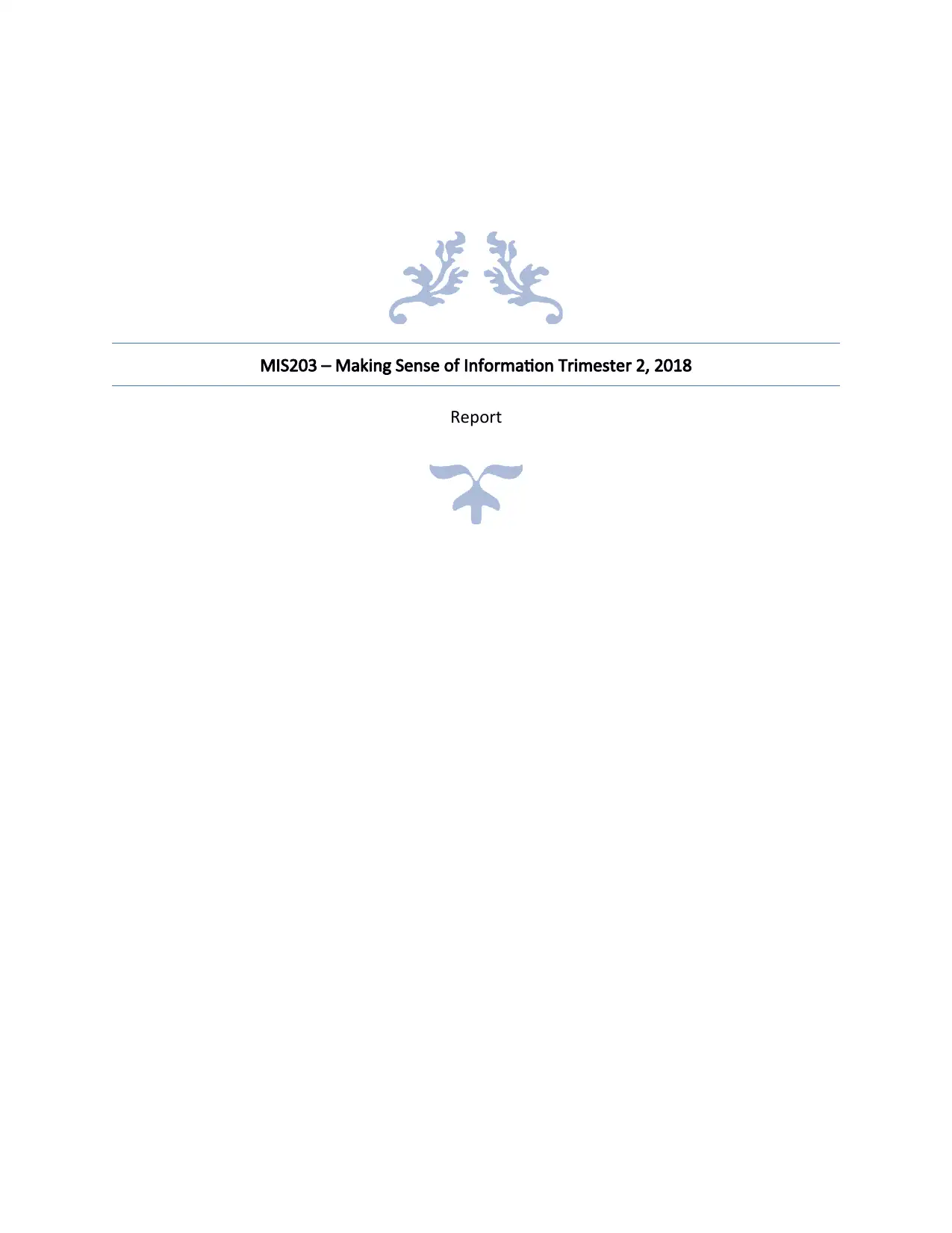
MIS203 – Making Sense of Information Trimester 2, 2018
Report
Report
Paraphrase This Document
Need a fresh take? Get an instant paraphrase of this document with our AI Paraphraser
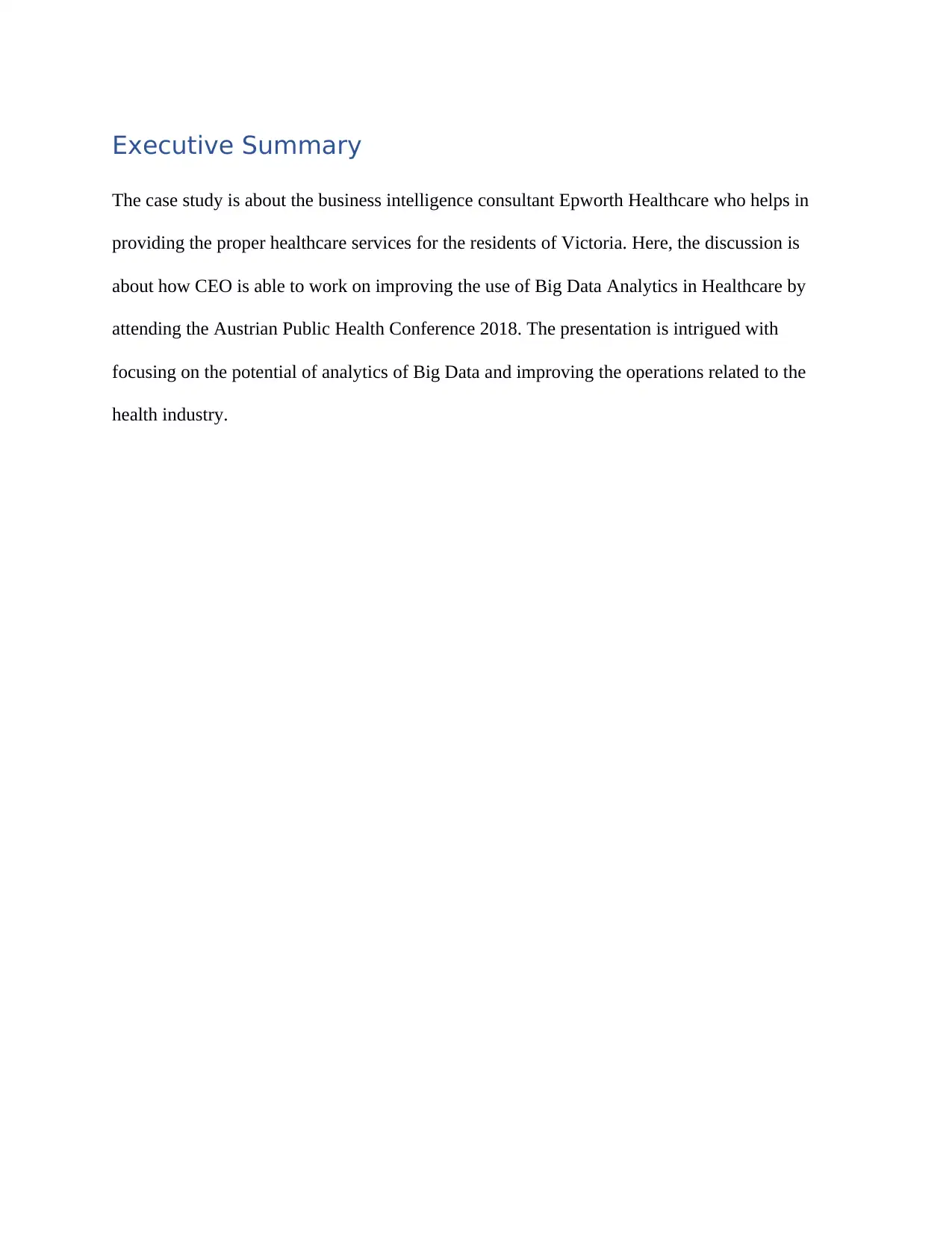
Executive Summary
The case study is about the business intelligence consultant Epworth Healthcare who helps in
providing the proper healthcare services for the residents of Victoria. Here, the discussion is
about how CEO is able to work on improving the use of Big Data Analytics in Healthcare by
attending the Austrian Public Health Conference 2018. The presentation is intrigued with
focusing on the potential of analytics of Big Data and improving the operations related to the
health industry.
The case study is about the business intelligence consultant Epworth Healthcare who helps in
providing the proper healthcare services for the residents of Victoria. Here, the discussion is
about how CEO is able to work on improving the use of Big Data Analytics in Healthcare by
attending the Austrian Public Health Conference 2018. The presentation is intrigued with
focusing on the potential of analytics of Big Data and improving the operations related to the
health industry.

Contents
Executive Summary.........................................................................................................................1
Introduction......................................................................................................................................2
Discussion........................................................................................................................................2
- Applications of Big Data analytics............................................................................................2
- Potential benefit and impacts of using Big Data analytics in Epworth Healthcare...................5
- Potential risks associated with Big Data analytics in Epworth Healthcare...............................6
Conclusion.......................................................................................................................................7
References........................................................................................................................................8
Executive Summary.........................................................................................................................1
Introduction......................................................................................................................................2
Discussion........................................................................................................................................2
- Applications of Big Data analytics............................................................................................2
- Potential benefit and impacts of using Big Data analytics in Epworth Healthcare...................5
- Potential risks associated with Big Data analytics in Epworth Healthcare...............................6
Conclusion.......................................................................................................................................7
References........................................................................................................................................8
⊘ This is a preview!⊘
Do you want full access?
Subscribe today to unlock all pages.

Trusted by 1+ million students worldwide
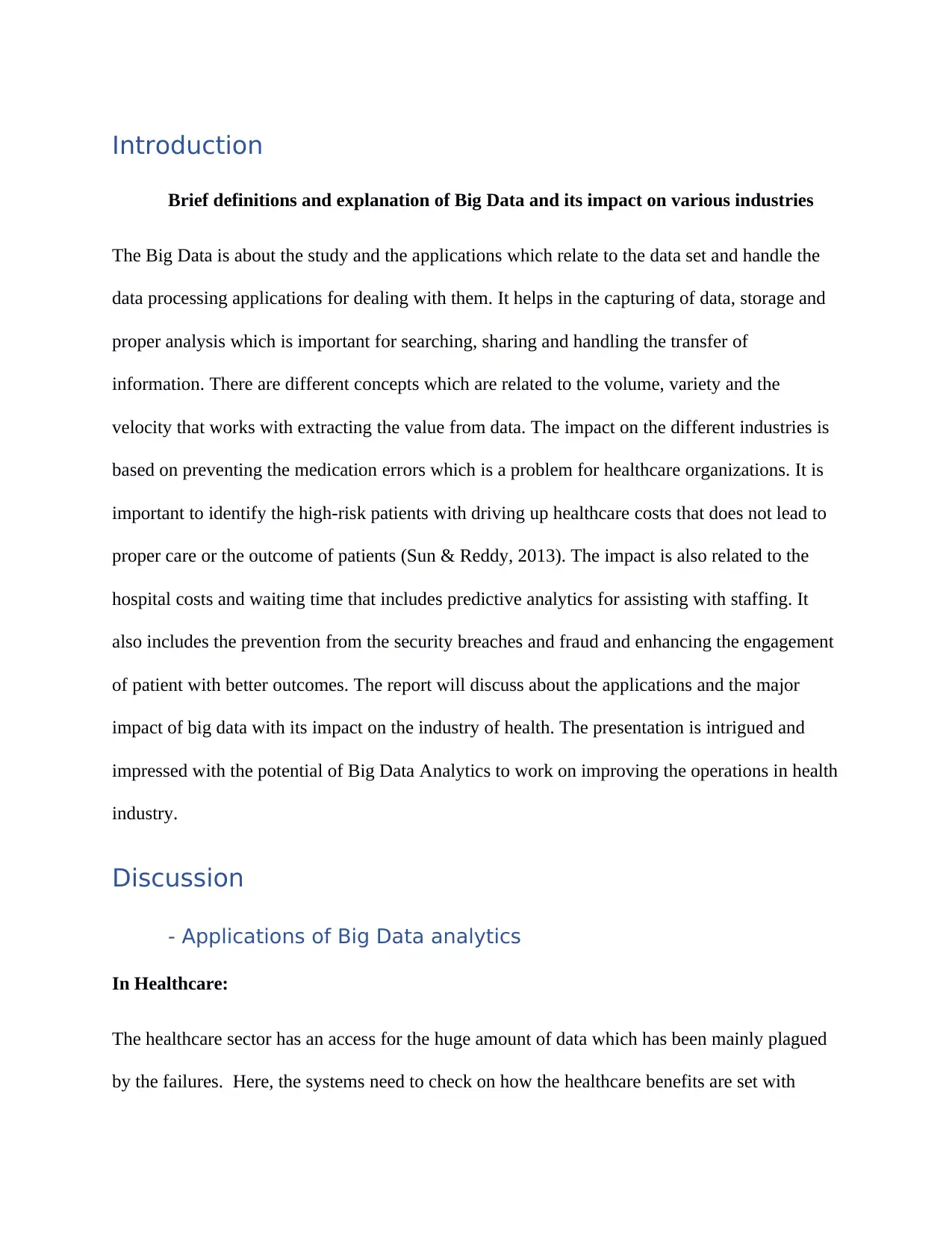
Introduction
Brief definitions and explanation of Big Data and its impact on various industries
The Big Data is about the study and the applications which relate to the data set and handle the
data processing applications for dealing with them. It helps in the capturing of data, storage and
proper analysis which is important for searching, sharing and handling the transfer of
information. There are different concepts which are related to the volume, variety and the
velocity that works with extracting the value from data. The impact on the different industries is
based on preventing the medication errors which is a problem for healthcare organizations. It is
important to identify the high-risk patients with driving up healthcare costs that does not lead to
proper care or the outcome of patients (Sun & Reddy, 2013). The impact is also related to the
hospital costs and waiting time that includes predictive analytics for assisting with staffing. It
also includes the prevention from the security breaches and fraud and enhancing the engagement
of patient with better outcomes. The report will discuss about the applications and the major
impact of big data with its impact on the industry of health. The presentation is intrigued and
impressed with the potential of Big Data Analytics to work on improving the operations in health
industry.
Discussion
- Applications of Big Data analytics
In Healthcare:
The healthcare sector has an access for the huge amount of data which has been mainly plagued
by the failures. Here, the systems need to check on how the healthcare benefits are set with
Brief definitions and explanation of Big Data and its impact on various industries
The Big Data is about the study and the applications which relate to the data set and handle the
data processing applications for dealing with them. It helps in the capturing of data, storage and
proper analysis which is important for searching, sharing and handling the transfer of
information. There are different concepts which are related to the volume, variety and the
velocity that works with extracting the value from data. The impact on the different industries is
based on preventing the medication errors which is a problem for healthcare organizations. It is
important to identify the high-risk patients with driving up healthcare costs that does not lead to
proper care or the outcome of patients (Sun & Reddy, 2013). The impact is also related to the
hospital costs and waiting time that includes predictive analytics for assisting with staffing. It
also includes the prevention from the security breaches and fraud and enhancing the engagement
of patient with better outcomes. The report will discuss about the applications and the major
impact of big data with its impact on the industry of health. The presentation is intrigued and
impressed with the potential of Big Data Analytics to work on improving the operations in health
industry.
Discussion
- Applications of Big Data analytics
In Healthcare:
The healthcare sector has an access for the huge amount of data which has been mainly plagued
by the failures. Here, the systems need to check on how the healthcare benefits are set with
Paraphrase This Document
Need a fresh take? Get an instant paraphrase of this document with our AI Paraphraser
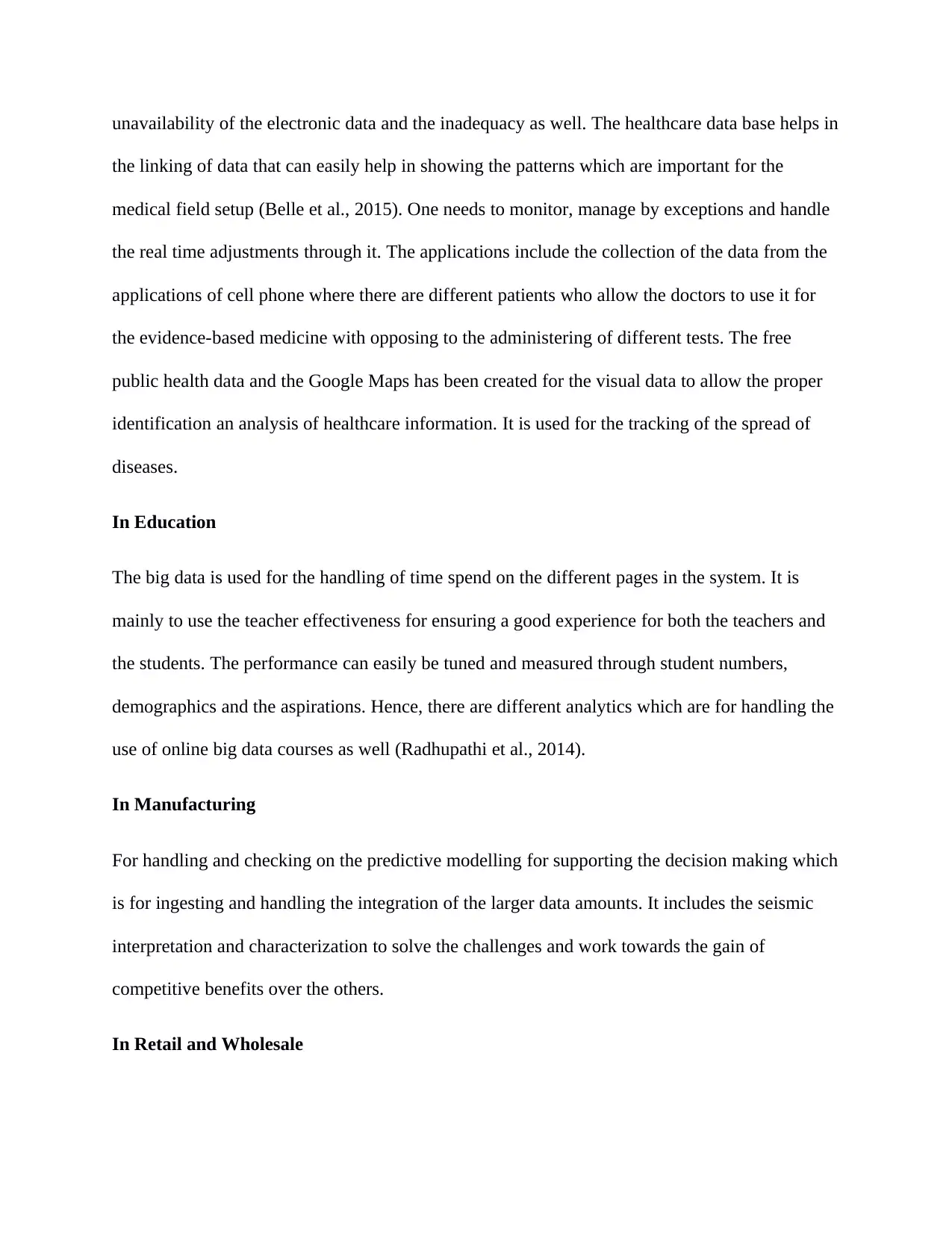
unavailability of the electronic data and the inadequacy as well. The healthcare data base helps in
the linking of data that can easily help in showing the patterns which are important for the
medical field setup (Belle et al., 2015). One needs to monitor, manage by exceptions and handle
the real time adjustments through it. The applications include the collection of the data from the
applications of cell phone where there are different patients who allow the doctors to use it for
the evidence-based medicine with opposing to the administering of different tests. The free
public health data and the Google Maps has been created for the visual data to allow the proper
identification an analysis of healthcare information. It is used for the tracking of the spread of
diseases.
In Education
The big data is used for the handling of time spend on the different pages in the system. It is
mainly to use the teacher effectiveness for ensuring a good experience for both the teachers and
the students. The performance can easily be tuned and measured through student numbers,
demographics and the aspirations. Hence, there are different analytics which are for handling the
use of online big data courses as well (Radhupathi et al., 2014).
In Manufacturing
For handling and checking on the predictive modelling for supporting the decision making which
is for ingesting and handling the integration of the larger data amounts. It includes the seismic
interpretation and characterization to solve the challenges and work towards the gain of
competitive benefits over the others.
In Retail and Wholesale
the linking of data that can easily help in showing the patterns which are important for the
medical field setup (Belle et al., 2015). One needs to monitor, manage by exceptions and handle
the real time adjustments through it. The applications include the collection of the data from the
applications of cell phone where there are different patients who allow the doctors to use it for
the evidence-based medicine with opposing to the administering of different tests. The free
public health data and the Google Maps has been created for the visual data to allow the proper
identification an analysis of healthcare information. It is used for the tracking of the spread of
diseases.
In Education
The big data is used for the handling of time spend on the different pages in the system. It is
mainly to use the teacher effectiveness for ensuring a good experience for both the teachers and
the students. The performance can easily be tuned and measured through student numbers,
demographics and the aspirations. Hence, there are different analytics which are for handling the
use of online big data courses as well (Radhupathi et al., 2014).
In Manufacturing
For handling and checking on the predictive modelling for supporting the decision making which
is for ingesting and handling the integration of the larger data amounts. It includes the seismic
interpretation and characterization to solve the challenges and work towards the gain of
competitive benefits over the others.
In Retail and Wholesale
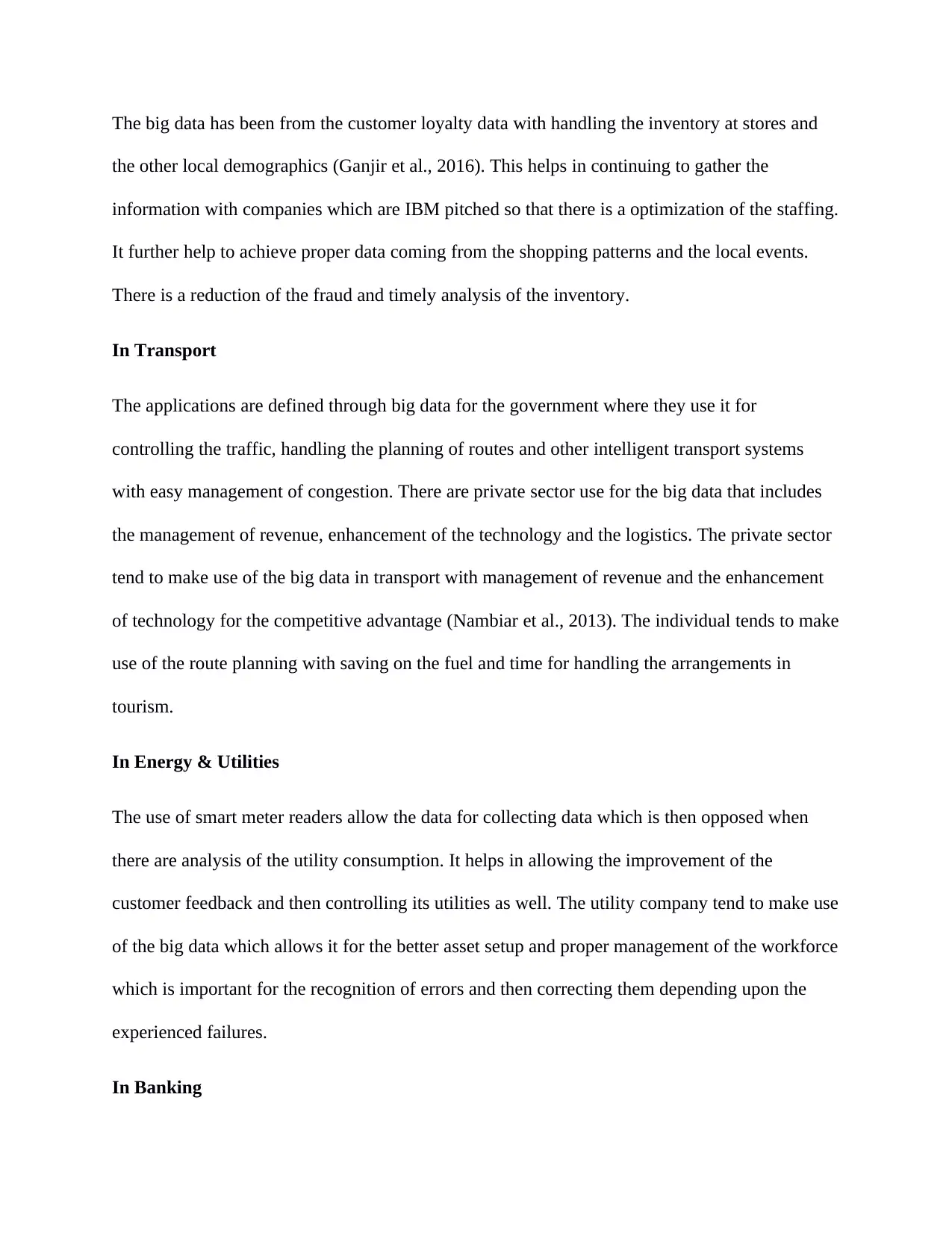
The big data has been from the customer loyalty data with handling the inventory at stores and
the other local demographics (Ganjir et al., 2016). This helps in continuing to gather the
information with companies which are IBM pitched so that there is a optimization of the staffing.
It further help to achieve proper data coming from the shopping patterns and the local events.
There is a reduction of the fraud and timely analysis of the inventory.
In Transport
The applications are defined through big data for the government where they use it for
controlling the traffic, handling the planning of routes and other intelligent transport systems
with easy management of congestion. There are private sector use for the big data that includes
the management of revenue, enhancement of the technology and the logistics. The private sector
tend to make use of the big data in transport with management of revenue and the enhancement
of technology for the competitive advantage (Nambiar et al., 2013). The individual tends to make
use of the route planning with saving on the fuel and time for handling the arrangements in
tourism.
In Energy & Utilities
The use of smart meter readers allow the data for collecting data which is then opposed when
there are analysis of the utility consumption. It helps in allowing the improvement of the
customer feedback and then controlling its utilities as well. The utility company tend to make use
of the big data which allows it for the better asset setup and proper management of the workforce
which is important for the recognition of errors and then correcting them depending upon the
experienced failures.
In Banking
the other local demographics (Ganjir et al., 2016). This helps in continuing to gather the
information with companies which are IBM pitched so that there is a optimization of the staffing.
It further help to achieve proper data coming from the shopping patterns and the local events.
There is a reduction of the fraud and timely analysis of the inventory.
In Transport
The applications are defined through big data for the government where they use it for
controlling the traffic, handling the planning of routes and other intelligent transport systems
with easy management of congestion. There are private sector use for the big data that includes
the management of revenue, enhancement of the technology and the logistics. The private sector
tend to make use of the big data in transport with management of revenue and the enhancement
of technology for the competitive advantage (Nambiar et al., 2013). The individual tends to make
use of the route planning with saving on the fuel and time for handling the arrangements in
tourism.
In Energy & Utilities
The use of smart meter readers allow the data for collecting data which is then opposed when
there are analysis of the utility consumption. It helps in allowing the improvement of the
customer feedback and then controlling its utilities as well. The utility company tend to make use
of the big data which allows it for the better asset setup and proper management of the workforce
which is important for the recognition of errors and then correcting them depending upon the
experienced failures.
In Banking
⊘ This is a preview!⊘
Do you want full access?
Subscribe today to unlock all pages.

Trusted by 1+ million students worldwide
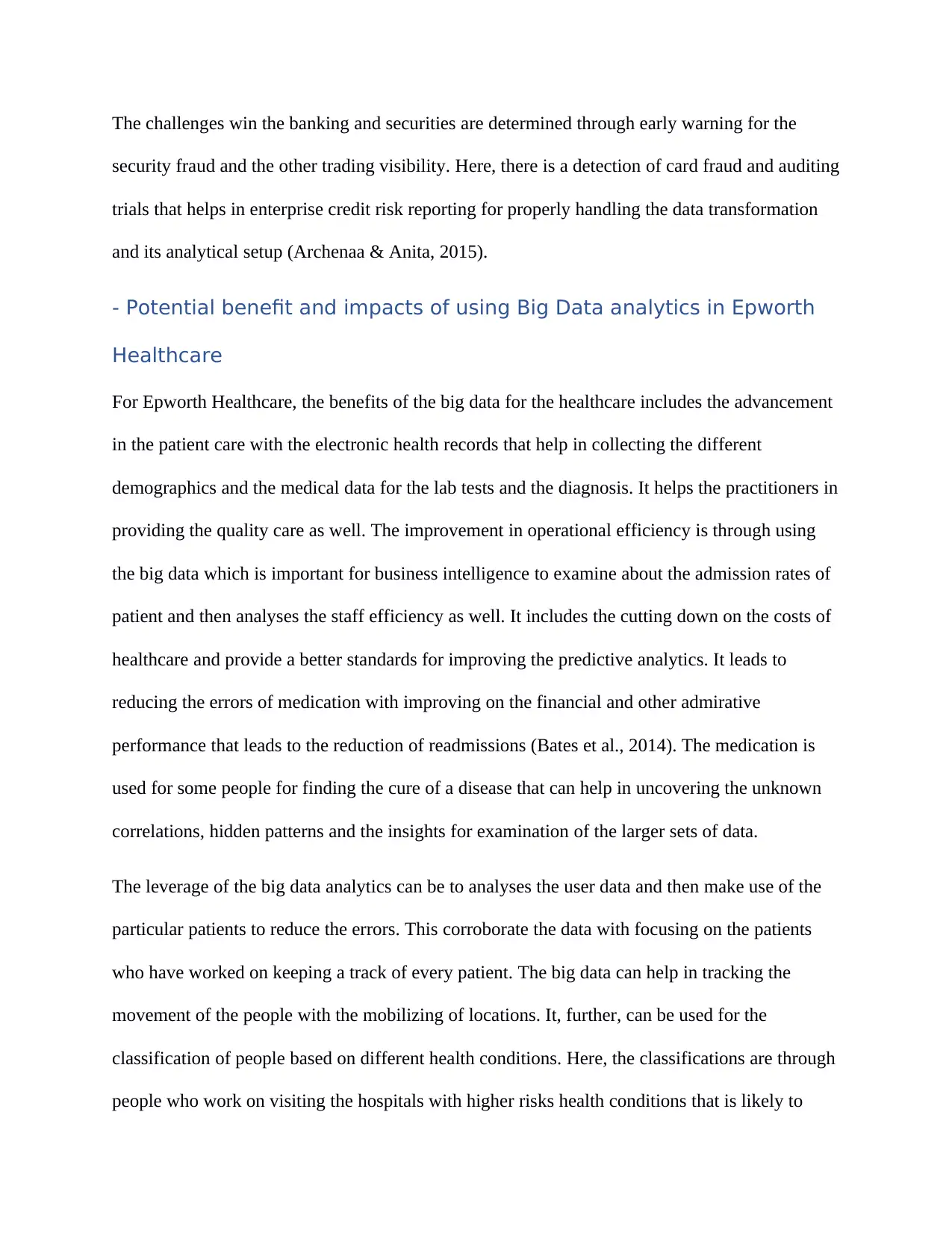
The challenges win the banking and securities are determined through early warning for the
security fraud and the other trading visibility. Here, there is a detection of card fraud and auditing
trials that helps in enterprise credit risk reporting for properly handling the data transformation
and its analytical setup (Archenaa & Anita, 2015).
- Potential benefit and impacts of using Big Data analytics in Epworth
Healthcare
For Epworth Healthcare, the benefits of the big data for the healthcare includes the advancement
in the patient care with the electronic health records that help in collecting the different
demographics and the medical data for the lab tests and the diagnosis. It helps the practitioners in
providing the quality care as well. The improvement in operational efficiency is through using
the big data which is important for business intelligence to examine about the admission rates of
patient and then analyses the staff efficiency as well. It includes the cutting down on the costs of
healthcare and provide a better standards for improving the predictive analytics. It leads to
reducing the errors of medication with improving on the financial and other admirative
performance that leads to the reduction of readmissions (Bates et al., 2014). The medication is
used for some people for finding the cure of a disease that can help in uncovering the unknown
correlations, hidden patterns and the insights for examination of the larger sets of data.
The leverage of the big data analytics can be to analyses the user data and then make use of the
particular patients to reduce the errors. This corroborate the data with focusing on the patients
who have worked on keeping a track of every patient. The big data can help in tracking the
movement of the people with the mobilizing of locations. It, further, can be used for the
classification of people based on different health conditions. Here, the classifications are through
people who work on visiting the hospitals with higher risks health conditions that is likely to
security fraud and the other trading visibility. Here, there is a detection of card fraud and auditing
trials that helps in enterprise credit risk reporting for properly handling the data transformation
and its analytical setup (Archenaa & Anita, 2015).
- Potential benefit and impacts of using Big Data analytics in Epworth
Healthcare
For Epworth Healthcare, the benefits of the big data for the healthcare includes the advancement
in the patient care with the electronic health records that help in collecting the different
demographics and the medical data for the lab tests and the diagnosis. It helps the practitioners in
providing the quality care as well. The improvement in operational efficiency is through using
the big data which is important for business intelligence to examine about the admission rates of
patient and then analyses the staff efficiency as well. It includes the cutting down on the costs of
healthcare and provide a better standards for improving the predictive analytics. It leads to
reducing the errors of medication with improving on the financial and other admirative
performance that leads to the reduction of readmissions (Bates et al., 2014). The medication is
used for some people for finding the cure of a disease that can help in uncovering the unknown
correlations, hidden patterns and the insights for examination of the larger sets of data.
The leverage of the big data analytics can be to analyses the user data and then make use of the
particular patients to reduce the errors. This corroborate the data with focusing on the patients
who have worked on keeping a track of every patient. The big data can help in tracking the
movement of the people with the mobilizing of locations. It, further, can be used for the
classification of people based on different health conditions. Here, the classifications are through
people who work on visiting the hospitals with higher risks health conditions that is likely to
Paraphrase This Document
Need a fresh take? Get an instant paraphrase of this document with our AI Paraphraser

affect the population as well. With BMI records of people, big data and predictive analytics help
in focusing at the risks of cardiac arrest with other health conditions like high cholesterol etc.,
that is for providing the care to the patients (Gandomi et al, 2015). The predictive analytics is for
the powerful tool for handling the admission rates that are set with attrition rate with properly
handling the staff allocation. The supply expenditures could be for handling the budget which is
through properly handling the procurement of the tools and the other medical facilities which are
increasing with tools and supplies. It includes the predictions based on the past year records that
can be estimated with enabling hospitals to save a larger amount of money with forecasting the
demands for the medical suppliers.
- Potential risks associated with Big Data analytics in Epworth
Healthcare
The potential big data analytics is considered to be one of the tough undertakings for handling
the electronic health records (EHR) for properly handling the actions with learning the
complicated initiatives as well. There are certain risks which could be administered in Epworth
Healthcare that includes:
a. Capture: It is related to how the data healthcare provides capturing of the data which is
clean, complete and accurate for properly handling the multiple systems which is one of
the problems for the organizations (Wang et al., 2018). The poor EHR visibility and the
convoluted workflows with the incomplete understanding of why big data is important
generally contributes to quality issues.
b. Cleaning: The healthcare providers are mainly focusing on the cleanliness and the
handling of operation rooms. The dirty data could lead to bringing the data resources with
recording the clinical and the other operational elements with ensuring about how
in focusing at the risks of cardiac arrest with other health conditions like high cholesterol etc.,
that is for providing the care to the patients (Gandomi et al, 2015). The predictive analytics is for
the powerful tool for handling the admission rates that are set with attrition rate with properly
handling the staff allocation. The supply expenditures could be for handling the budget which is
through properly handling the procurement of the tools and the other medical facilities which are
increasing with tools and supplies. It includes the predictions based on the past year records that
can be estimated with enabling hospitals to save a larger amount of money with forecasting the
demands for the medical suppliers.
- Potential risks associated with Big Data analytics in Epworth
Healthcare
The potential big data analytics is considered to be one of the tough undertakings for handling
the electronic health records (EHR) for properly handling the actions with learning the
complicated initiatives as well. There are certain risks which could be administered in Epworth
Healthcare that includes:
a. Capture: It is related to how the data healthcare provides capturing of the data which is
clean, complete and accurate for properly handling the multiple systems which is one of
the problems for the organizations (Wang et al., 2018). The poor EHR visibility and the
convoluted workflows with the incomplete understanding of why big data is important
generally contributes to quality issues.
b. Cleaning: The healthcare providers are mainly focusing on the cleanliness and the
handling of operation rooms. The dirty data could lead to bringing the data resources with
recording the clinical and the other operational elements with ensuring about how
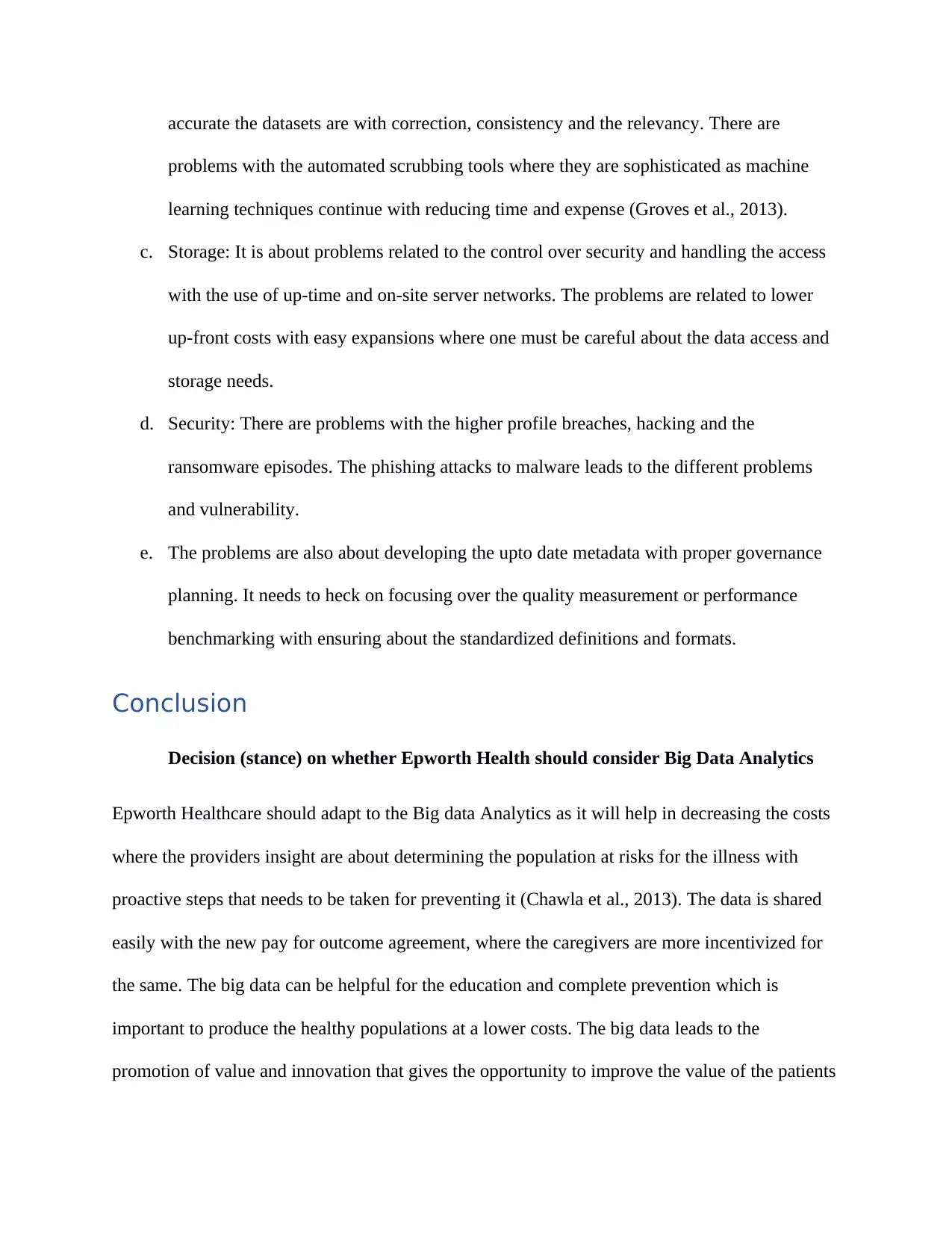
accurate the datasets are with correction, consistency and the relevancy. There are
problems with the automated scrubbing tools where they are sophisticated as machine
learning techniques continue with reducing time and expense (Groves et al., 2013).
c. Storage: It is about problems related to the control over security and handling the access
with the use of up-time and on-site server networks. The problems are related to lower
up-front costs with easy expansions where one must be careful about the data access and
storage needs.
d. Security: There are problems with the higher profile breaches, hacking and the
ransomware episodes. The phishing attacks to malware leads to the different problems
and vulnerability.
e. The problems are also about developing the upto date metadata with proper governance
planning. It needs to heck on focusing over the quality measurement or performance
benchmarking with ensuring about the standardized definitions and formats.
Conclusion
Decision (stance) on whether Epworth Health should consider Big Data Analytics
Epworth Healthcare should adapt to the Big data Analytics as it will help in decreasing the costs
where the providers insight are about determining the population at risks for the illness with
proactive steps that needs to be taken for preventing it (Chawla et al., 2013). The data is shared
easily with the new pay for outcome agreement, where the caregivers are more incentivized for
the same. The big data can be helpful for the education and complete prevention which is
important to produce the healthy populations at a lower costs. The big data leads to the
promotion of value and innovation that gives the opportunity to improve the value of the patients
problems with the automated scrubbing tools where they are sophisticated as machine
learning techniques continue with reducing time and expense (Groves et al., 2013).
c. Storage: It is about problems related to the control over security and handling the access
with the use of up-time and on-site server networks. The problems are related to lower
up-front costs with easy expansions where one must be careful about the data access and
storage needs.
d. Security: There are problems with the higher profile breaches, hacking and the
ransomware episodes. The phishing attacks to malware leads to the different problems
and vulnerability.
e. The problems are also about developing the upto date metadata with proper governance
planning. It needs to heck on focusing over the quality measurement or performance
benchmarking with ensuring about the standardized definitions and formats.
Conclusion
Decision (stance) on whether Epworth Health should consider Big Data Analytics
Epworth Healthcare should adapt to the Big data Analytics as it will help in decreasing the costs
where the providers insight are about determining the population at risks for the illness with
proactive steps that needs to be taken for preventing it (Chawla et al., 2013). The data is shared
easily with the new pay for outcome agreement, where the caregivers are more incentivized for
the same. The big data can be helpful for the education and complete prevention which is
important to produce the healthy populations at a lower costs. The big data leads to the
promotion of value and innovation that gives the opportunity to improve the value of the patients
⊘ This is a preview!⊘
Do you want full access?
Subscribe today to unlock all pages.

Trusted by 1+ million students worldwide
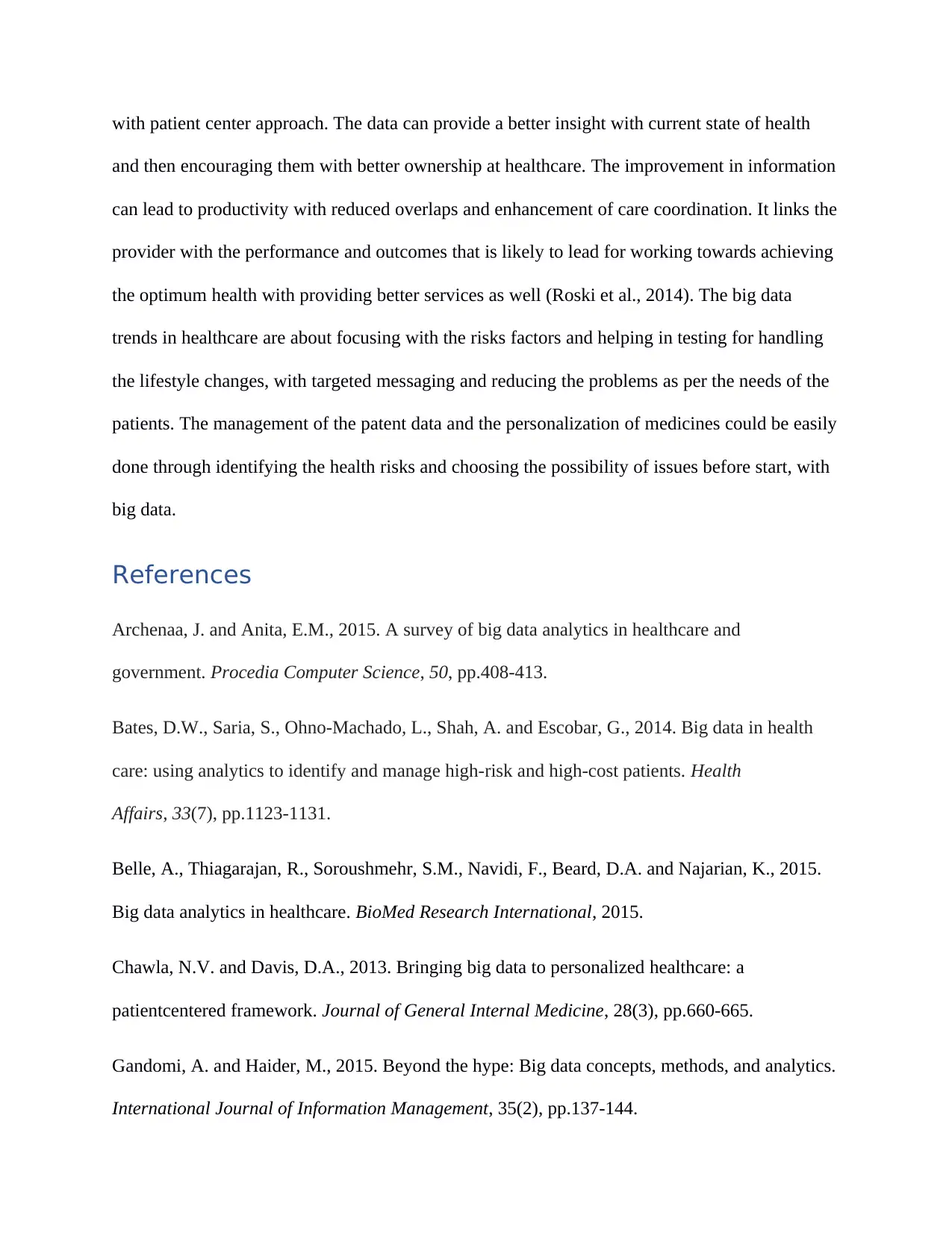
with patient center approach. The data can provide a better insight with current state of health
and then encouraging them with better ownership at healthcare. The improvement in information
can lead to productivity with reduced overlaps and enhancement of care coordination. It links the
provider with the performance and outcomes that is likely to lead for working towards achieving
the optimum health with providing better services as well (Roski et al., 2014). The big data
trends in healthcare are about focusing with the risks factors and helping in testing for handling
the lifestyle changes, with targeted messaging and reducing the problems as per the needs of the
patients. The management of the patent data and the personalization of medicines could be easily
done through identifying the health risks and choosing the possibility of issues before start, with
big data.
References
Archenaa, J. and Anita, E.M., 2015. A survey of big data analytics in healthcare and
government. Procedia Computer Science, 50, pp.408-413.
Bates, D.W., Saria, S., Ohno-Machado, L., Shah, A. and Escobar, G., 2014. Big data in health
care: using analytics to identify and manage high-risk and high-cost patients. Health
Affairs, 33(7), pp.1123-1131.
Belle, A., Thiagarajan, R., Soroushmehr, S.M., Navidi, F., Beard, D.A. and Najarian, K., 2015.
Big data analytics in healthcare. BioMed Research International, 2015.
Chawla, N.V. and Davis, D.A., 2013. Bringing big data to personalized healthcare: a
patientcentered framework. Journal of General Internal Medicine, 28(3), pp.660-665.
Gandomi, A. and Haider, M., 2015. Beyond the hype: Big data concepts, methods, and analytics.
International Journal of Information Management, 35(2), pp.137-144.
and then encouraging them with better ownership at healthcare. The improvement in information
can lead to productivity with reduced overlaps and enhancement of care coordination. It links the
provider with the performance and outcomes that is likely to lead for working towards achieving
the optimum health with providing better services as well (Roski et al., 2014). The big data
trends in healthcare are about focusing with the risks factors and helping in testing for handling
the lifestyle changes, with targeted messaging and reducing the problems as per the needs of the
patients. The management of the patent data and the personalization of medicines could be easily
done through identifying the health risks and choosing the possibility of issues before start, with
big data.
References
Archenaa, J. and Anita, E.M., 2015. A survey of big data analytics in healthcare and
government. Procedia Computer Science, 50, pp.408-413.
Bates, D.W., Saria, S., Ohno-Machado, L., Shah, A. and Escobar, G., 2014. Big data in health
care: using analytics to identify and manage high-risk and high-cost patients. Health
Affairs, 33(7), pp.1123-1131.
Belle, A., Thiagarajan, R., Soroushmehr, S.M., Navidi, F., Beard, D.A. and Najarian, K., 2015.
Big data analytics in healthcare. BioMed Research International, 2015.
Chawla, N.V. and Davis, D.A., 2013. Bringing big data to personalized healthcare: a
patientcentered framework. Journal of General Internal Medicine, 28(3), pp.660-665.
Gandomi, A. and Haider, M., 2015. Beyond the hype: Big data concepts, methods, and analytics.
International Journal of Information Management, 35(2), pp.137-144.
Paraphrase This Document
Need a fresh take? Get an instant paraphrase of this document with our AI Paraphraser
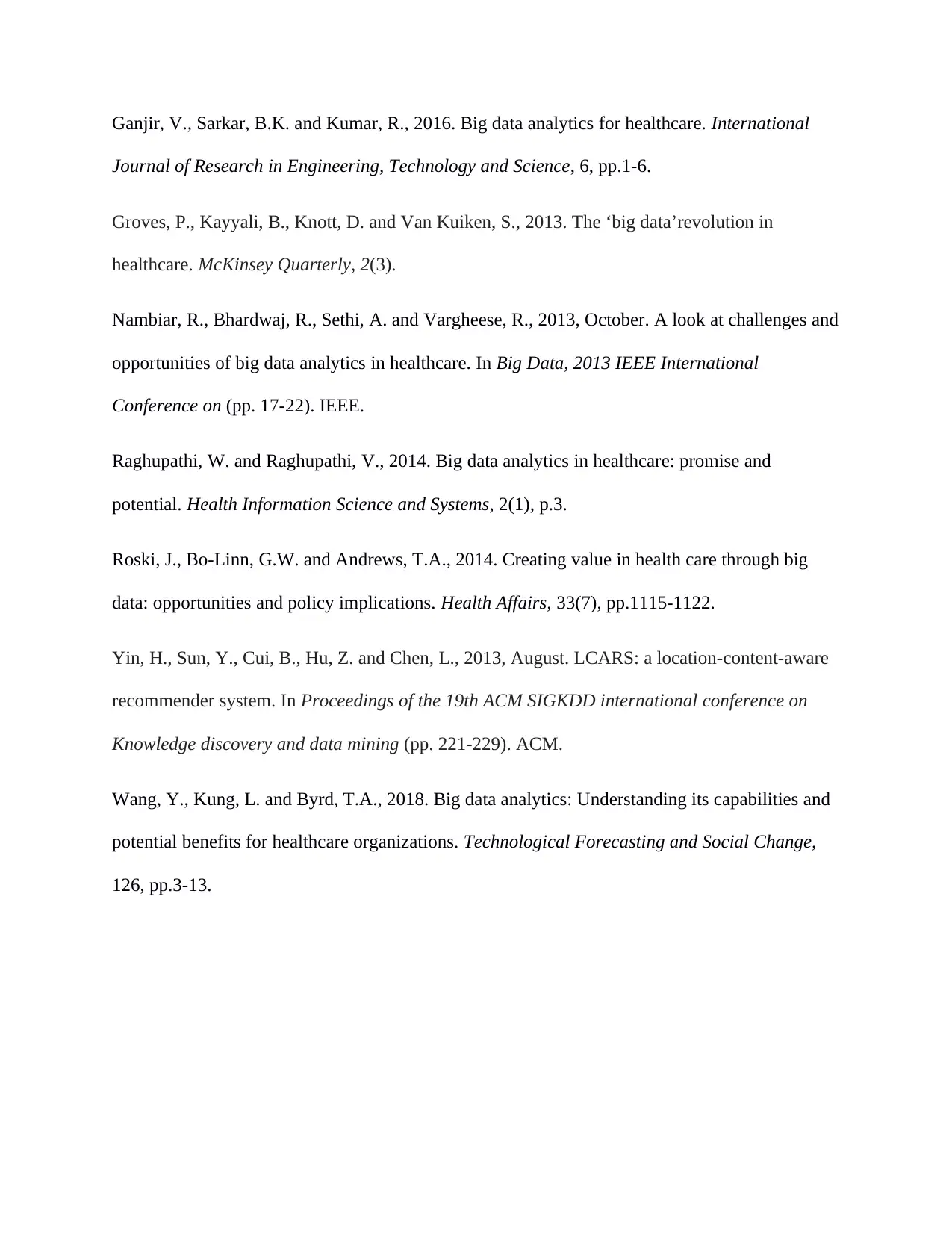
Ganjir, V., Sarkar, B.K. and Kumar, R., 2016. Big data analytics for healthcare. International
Journal of Research in Engineering, Technology and Science, 6, pp.1-6.
Groves, P., Kayyali, B., Knott, D. and Van Kuiken, S., 2013. The ‘big data’revolution in
healthcare. McKinsey Quarterly, 2(3).
Nambiar, R., Bhardwaj, R., Sethi, A. and Vargheese, R., 2013, October. A look at challenges and
opportunities of big data analytics in healthcare. In Big Data, 2013 IEEE International
Conference on (pp. 17-22). IEEE.
Raghupathi, W. and Raghupathi, V., 2014. Big data analytics in healthcare: promise and
potential. Health Information Science and Systems, 2(1), p.3.
Roski, J., Bo-Linn, G.W. and Andrews, T.A., 2014. Creating value in health care through big
data: opportunities and policy implications. Health Affairs, 33(7), pp.1115-1122.
Yin, H., Sun, Y., Cui, B., Hu, Z. and Chen, L., 2013, August. LCARS: a location-content-aware
recommender system. In Proceedings of the 19th ACM SIGKDD international conference on
Knowledge discovery and data mining (pp. 221-229). ACM.
Wang, Y., Kung, L. and Byrd, T.A., 2018. Big data analytics: Understanding its capabilities and
potential benefits for healthcare organizations. Technological Forecasting and Social Change,
126, pp.3-13.
Journal of Research in Engineering, Technology and Science, 6, pp.1-6.
Groves, P., Kayyali, B., Knott, D. and Van Kuiken, S., 2013. The ‘big data’revolution in
healthcare. McKinsey Quarterly, 2(3).
Nambiar, R., Bhardwaj, R., Sethi, A. and Vargheese, R., 2013, October. A look at challenges and
opportunities of big data analytics in healthcare. In Big Data, 2013 IEEE International
Conference on (pp. 17-22). IEEE.
Raghupathi, W. and Raghupathi, V., 2014. Big data analytics in healthcare: promise and
potential. Health Information Science and Systems, 2(1), p.3.
Roski, J., Bo-Linn, G.W. and Andrews, T.A., 2014. Creating value in health care through big
data: opportunities and policy implications. Health Affairs, 33(7), pp.1115-1122.
Yin, H., Sun, Y., Cui, B., Hu, Z. and Chen, L., 2013, August. LCARS: a location-content-aware
recommender system. In Proceedings of the 19th ACM SIGKDD international conference on
Knowledge discovery and data mining (pp. 221-229). ACM.
Wang, Y., Kung, L. and Byrd, T.A., 2018. Big data analytics: Understanding its capabilities and
potential benefits for healthcare organizations. Technological Forecasting and Social Change,
126, pp.3-13.
1 out of 11
Related Documents
Your All-in-One AI-Powered Toolkit for Academic Success.
+13062052269
info@desklib.com
Available 24*7 on WhatsApp / Email
![[object Object]](/_next/static/media/star-bottom.7253800d.svg)
Unlock your academic potential
Copyright © 2020–2025 A2Z Services. All Rights Reserved. Developed and managed by ZUCOL.





